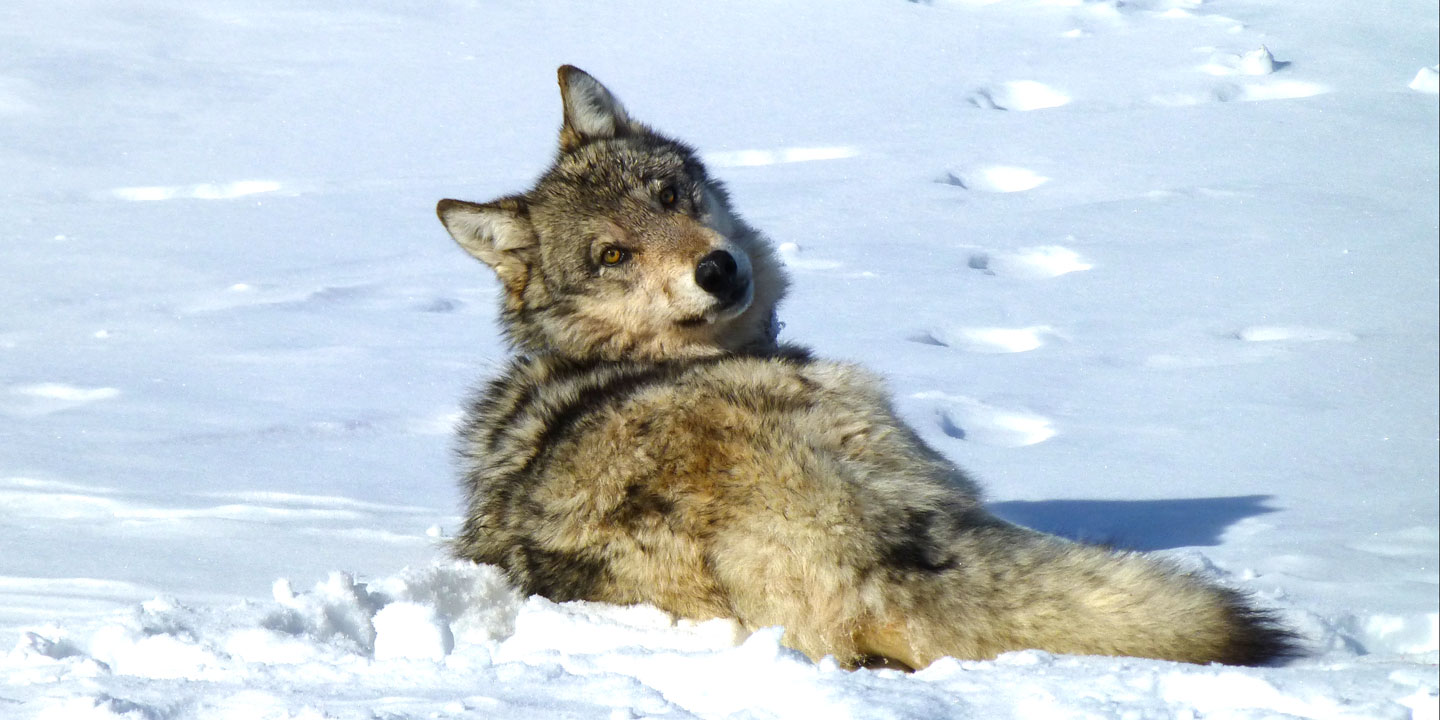Gray wolf
Status: Endangered

The Gray Wolf (Canis lupus) is the largest member of the canid family which includes coyotes, red foxes, gray foxes, swift foxes and domesticated dogs. Size is the main way to differentiate wolves from their canine cousins. Wolves typically range from 5-6.6 feet (tip of nose to tip of tail) for males and 4.5-6 feet long for females. They weigh between 70-115 pounds for males and 60-100 pounds for females. Wolves in the northern part of their range tend to be larger than those in the southern part of the range. Males also tend to be slightly larger than females.
Gray Wolves can range in color from gray, white, black and brown. Often their fur is tipped in black and or gray. Their tail is longer than 18 inches and is tipped in black. Their ears are erect and triangular in shape, but more rounded than coyotes. Their track is large often reaching 4 inches with claws visible. Several domesticated dogs – St. Bernard, Great Danes, some Labradors, and Bloodhounds – have tracks as large as a wolf.
Like coyotes, wolves are extremely vocal and have a distinctive howl. Why wolves howl has been the basis for much research. Howling helps both pairs and the pack bond. Additionally, howling may be a way for wolves to indicate the beginning or end of a hunt or to warn other wolves to stay out of their range. Howling may also be used as an alarm or to locate members of their pack.
Distribution
Historically, the Gray Wolf was found across the United States from the Pacific Ocean to the Atlantic and from Alaska into Mexico. They were not present in the southeast due to the presence of Red Wolves.
There are currently four distinct populations of Gray Wolves: Western Great Lakes, Northern Rocky Mountains, Southwest Recovery Area and Alaska.
Although Gray Wolves typically are not found in Nebraska, they are a native species, as the state was part of their historic range.
Diet
Gray Wolves eat a variety of food including deer, moose, elk, beaver and bison. They will also take insects, small mammals, berries and nuts. These amazing predators may not eat for several days, but can also eat up to 20 pounds of food in a single meal.
Wolves often prey upon the young, old and weak individuals. Because taking a healthy adult moose or elk can be dangerous for even a pack of wolves, preying on young, old or weak individuals helps ensure the wolves do not get hurt.
Habitat
The Gray Wolf is extremely adaptable and can be found in a wide range of habitats including prairie, mountains, temperate forests, wetlands, tundra, and taiga. Wolves can survive anywhere there is plenty of food, water, shelter and space. In the modern landscape, they also need to live in areas where they are accepted by people in order to ensure they can thrive.
Reproduction
Although the wolf pack includes several adult members, it is only the alpha pair that breed. Breeding occurs from late January to March with a gestation period of 63 days. Litters of 4-6 pups are born from late March to May in a den. Dens can include burrows in the ground, a hollow log or a cave.
Pups are born covered in fuzzy fur and weigh about a pound. They are deaf and blind at birth with their eyes at two weeks of age and can hear at three weeks. They are weaned from their mother’s milk at about six weeks when they begin to eat meat brought to them by adults. The entire pack help care for the pups.
By September, pups are nearly fully grown and are regularly traveling with the adults.
At about 3 years old, wolves often leave the pack to look for a mate. During this search, wolves may travel hundreds of miles. They must be extremely careful when entering the territory of other packs.
If a wolf chooses to stay in its original pack, it will help raise the young and wait for its turn (if ever) to rise to reproduce.
Wolves can live in the wild up to 13 years and remain reproductively active until approximately 10 years old.
Population status
Once a critical keystone predator species that was found in a wide variety of habitats across the United States, Gray Wolf populations declined rapidly in the 1800s due to high prices for hides, government-sponsored predator control programs, direct killing by settlers through poisoning, trapping and shooting, as well as loss of habitat. By the early 1900s, populations of Gray Wolves were nearly eliminated.
The Gray Wolf was added to the federal Endangered species list in 1978 except in Minnesota where it was listed as Threatened. In 2011, the Idaho and Montana populations were delisted due to conservation efforts and population recovery. In 2017, the Northern Rockies population in Idaho, Montana, eastern Washington, eastern Oregon and Wyoming was delisted due to population recovery. In January 2021, the Gray Wolf was delisted federally due to population recovery; however, in February 2022 the decision to delist wolves was overturned, reinstating federal protection for wolves in 44 of the lower 48 states — including Nebraska.
Gray Wolves are not typically found in Nebraska, other than a few dispersers from time-to-time, although the state was part of the species historic range. An in-depth feature published by Nebraskaland Magazine sheds more light on Nebraska’s wolf population.
There are currently four distinct populations of Gray Wolves: Western Great Lakes, Northern Rocky Mountains, Southwest Recovery Area and Alaska. The total population of Gray Wolves is approximately 13,380-16,880 individuals.
Management and outlook
From near extinction to healthy populations, the Gray Wolf can be considered a true success story for the Endangered Species Act. Although more work is needed, there is certainly success to be celebrated.
Conservation help
Individuals wanting to help can learn about wolves, their history, behavior and natural history. Share this knowledge with others to help create a citizenry who understands the ecological role wolves play and the need for healthy wolf populations that fit within the modern landscape.
Donating funds to organizations dedicated to wolf research and habitat conservation can also play a role in the recovery of Gray Wolves. The more that is known about wolf behavior and natural history, the better we will be able to strive for a complete species recovery.
References
ECOS: Environmental Conservation Online System: Gray Wolf. U.S. Fish and Wildlife Service. Accessed December 2017.
Gray Wolf Fact Sheet. U.S. Fish and Wildlife Service. December 2011.
Questions and Answers about Gray Wolf Biology. U.S. Fish and Wildlife Service. December 2011.
Biology and Behavior. International Wolf Center. Accessed December 2017.




